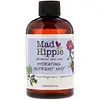What's inside
What's inside
 Key Ingredients
Key Ingredients

 Benefits
Benefits

 Ingredients Side-by-side
Ingredients Side-by-side

Aloe Barbadensis Leaf Juice
Skin ConditioningWater
Skin ConditioningGlycerin
HumectantPanthenol
Skin ConditioningSodium PCA
HumectantTocopherol
AntioxidantSorbitan Oleate Decylglucoside Crosspolymer
CleansingMalus Domestica Fruit Cell Culture Extract
Skin ConditioningMagnesium Ascorbyl Phosphate
AntioxidantCitrus Clementina Fruit Extract
Skin ConditioningCucumis Melo Fruit Extract
Skin ConditioningAllantoin
Skin ConditioningAspalathus Linearis Extract
Skin ConditioningHibiscus Sabdariffa Flower Extract
Skin ConditioningCamellia Sinensis Leaf Extract
AntimicrobialPhenethyl Alcohol
MaskingEthylhexylglycerin
Skin ConditioningCitrus Aurantium Dulcis Peel Oil
MaskingCymbopogon Martini Oil
MaskingAloe Barbadensis Leaf Juice, Water, Glycerin, Panthenol, Sodium PCA, Tocopherol, Sorbitan Oleate Decylglucoside Crosspolymer, Malus Domestica Fruit Cell Culture Extract, Magnesium Ascorbyl Phosphate, Citrus Clementina Fruit Extract, Cucumis Melo Fruit Extract, Allantoin, Aspalathus Linearis Extract, Hibiscus Sabdariffa Flower Extract, Camellia Sinensis Leaf Extract, Phenethyl Alcohol, Ethylhexylglycerin, Citrus Aurantium Dulcis Peel Oil, Cymbopogon Martini Oil
Water
Skin ConditioningAscorbic Acid
AntioxidantPhenethyl Alcohol
MaskingCaprylyl Glycol
EmollientEthylhexylglycerin
Skin ConditioningGlycerin
HumectantSodium PCA
HumectantCamellia Sinensis Leaf Extract
AntimicrobialCitrus Aurantifolia Peel Extract
CleansingSodium Hyaluronate
HumectantFerulic Acid
AntimicrobialHesperidin
EmollientVitis Vinifera Seed Extract
AntimicrobialGinkgo Biloba Leaf Extract
Skin ConditioningPunica Granatum Extract
AstringentResveratrol
AntioxidantSorbitan Oleate Decylglucoside Crosspolymer
CleansingBeta-Glucan
Skin ConditioningAcetyl Glucosamine
Skin ConditioningPinus Strobus Bark Extract
Skin ConditioningGlycine Soja Sterols
EmollientSophora Japonica Fruit Extract
Skin ConditioningSilybum Marianum Fruit Extract
Skin ConditioningThioctic Acid
AntioxidantWater, Ascorbic Acid, Phenethyl Alcohol, Caprylyl Glycol, Ethylhexylglycerin, Glycerin, Sodium PCA, Camellia Sinensis Leaf Extract, Citrus Aurantifolia Peel Extract, Sodium Hyaluronate, Ferulic Acid, Hesperidin, Vitis Vinifera Seed Extract, Ginkgo Biloba Leaf Extract, Punica Granatum Extract, Resveratrol, Sorbitan Oleate Decylglucoside Crosspolymer, Beta-Glucan, Acetyl Glucosamine, Pinus Strobus Bark Extract, Glycine Soja Sterols, Sophora Japonica Fruit Extract, Silybum Marianum Fruit Extract, Thioctic Acid
Ingredients Explained
These ingredients are found in both products.
Ingredients higher up in an ingredient list are typically present in a larger amount.
Camellia Sinensis Leaf Extract is derived from the leaves of the tea plant. Black tea, green tea, and oolong tea are all harvested from this plant.
This ingredient has many skin benefits:
This ingredient contains polyphenols, a strong antioxidant. Antioxidants help fight off molecules that damage skin cells.
On top of that, the antioxidants in green tea neutralize free-radicals from the sun. This gives the skin some extra UV protection, but should not replace sunscreen.
Many components of tea have anti-inflammatory properties.
Polyphenols and L-theanine help soothe the skin and reduce irritation. The caffeine in Camellia Sinensis Leaf Extract helps calm inflamed blood vessels.
Other compounds found in tea include: Vitamin Bs, linoleic acid, magnesium, calcium, iron, and zinc.
Research has shown both drinking Camellia Sinensis Leaf Tea and applying it to the skin can help boost skin elasticity and hydration. Studies also show using tea extract may reduce sebum, or oil, production.
Learn more about Camellia Sinensis Leaf ExtractEthylhexylglycerin (we can't pronounce this either) is commonly used as a preservative and skin softener. It is derived from glyceryl.
You might see Ethylhexylglycerin often paired with other preservatives such as phenoxyethanol. Ethylhexylglycerin has been found to increase the effectiveness of these other preservatives.
Glycerin is already naturally found in your skin. It helps moisturize and protect your skin.
A study from 2016 found glycerin to be more effective as a humectant than AHAs and hyaluronic acid.
As a humectant, it helps the skin stay hydrated by pulling moisture to your skin. The low molecular weight of glycerin allows it to pull moisture into the deeper layers of your skin.
Hydrated skin improves your skin barrier; Your skin barrier helps protect against irritants and bacteria.
Glycerin has also been found to have antimicrobial and antiviral properties. Due to these properties, glycerin is often used in wound and burn treatments.
In cosmetics, glycerin is usually derived from plants such as soybean or palm. However, it can also be sourced from animals, such as tallow or animal fat.
This ingredient is organic, colorless, odorless, and non-toxic.
Glycerin is the name for this ingredient in American English. British English uses Glycerol/Glycerine.
Learn more about GlycerinPhenethyl Alcohol is a colorless and aromatic alohol. It is naturally occuring in essential oils.
The scent of this ingredient is floral and often compared to rose.
Like other alcohols, this ingredient helps prevent the growth of bacteria. However, its main purpose is to impact a fragrance.
Learn more about Phenethyl AlcoholSodium PCA is the sodium salt of pyroglutamic acid. It is naturally occurring in our skin's natural moisturizing factors where it works to maintain hydration.
The PCA stands for pyrrolidone carboxylic acid, a natural amino acid derivative.
This ingredient has skin conditioning, anti-inflammatory, and humectant properties. Humectants help hydrate your skin by drawing moisture from the air. This helps keep your skin moisturized.
Learn more about Sodium PCASorbitan Oleate Decylglucoside Crosspolymer is also known as Poly Suga®Mulse D9 (We'll call is SODC for short).
SODC is a nonionic fragrance solubilizer. A solubilizer blends small amounts of oils into water-based formulas. It is especially good at solubilizing fragrances in water-only systems.
SODC does not contain PEGs. It is hydrophilic, meaning it has the tendency to mix with water.
In products, SODC acts as an emulsifer by blending waters and oils.
Learn more about Sorbitan Oleate Decylglucoside CrosspolymerWater. It's the most common cosmetic ingredient of all. You'll usually see it at the top of ingredient lists, meaning that it makes up the largest part of the product.
So why is it so popular? Water most often acts as a solvent - this means that it helps dissolve other ingredients into the formulation.
You'll also recognize water as that liquid we all need to stay alive. If you see this, drink a glass of water. Stay hydrated!
Learn more about Water